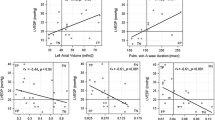Abstract
Background
This study aimed to assess the prevalence of right ventricular diastolic dysfunction (RVDD) and its potential predictors in peripartum cardiomyopathy (PPCM) patients.
Methods
This was a cross-sectional study carried out in Nigeria. RVDD was defined and graded using Doppler filling and myocardial tissue Doppler velocities obtained at tricuspid annular level.
Results
Forty-three subjects with PPCM and mean age of 26.6 ± 7.0 years were recruited over 6 months. RVDD was found in 30 (69.8 %) subjects, of whom 16 (53.3 %) had grade I, 12 (40.0 %) had grade II and 2 (6.7 %) had grade III severity. RV systolic dysfunction (RVSD), defined as RV fractional area change <35 %, was found in 88.4 %, while combined RVSD and RVDD was found in 58.1 % of patients. Subjects with RVDD had significantly higher tricuspid E/e′ ratio (5.1 ± 2.8 versus 3.5 ± 1.0, p = 0.012) and prevalence of pulmonary hypertension (76.7 versus 46.2 %; p < 0.05), and lower serum selenium concentration (55.6 ± 12.1 versus 72.5 ± 12.0 µg/L, p = 0.001) than those with preserved RV diastolic function. Regression analyses showed serum selenium [odds ratio (OR) = 1.14; 95 % confidence interval (CI) = 1.0–1.3; p = 0.049] and combined RVSD and pulmonary hypertension (OR = 79.2; CI = 3.9–1593.7; p = 0.004) as the only predictors of RVDD, and serum selenium <70 µg/L increased the odds of RVDD by 6.67-fold (CI = 1.18–37.78; p = 0.032).
Conclusions
Both RVDD and RVSD were common in PPCM patients. Selenium deficiency and combined RVSD and pulmonary hypertension seemed to be the only determinants of RVDD in this small cohort, a finding that needs verification in a larger sample of patients.


Similar content being viewed by others
References
Karaye KM, Lindmark K, Henein MY. One year survival in Nigerians with peripartum cardiomyopathy. Heart Views. 2016;17:55–61.
Sliwa K, Hilfiker-Kleiner D, Petrie MC, et al. Heart Failure Association of the European Society of Cardiology Working Group on Peripartum Cardiomyopathy. Current state of knowledge on aetiology, diagnosis, management, and therapy of peripartum cardiomyopathy: a position statement from the Heart Failure Association of the European Society of Cardiology Working Group on peripartum cardiomyopathy. Eur J Heart Fail. 2010;12(8):767–78.
Karaye KM, Lindmark K, Henein MY. Right ventricular systolic dysfunction and remodelling in Nigerians with peripartum cardiomyopathy: a longitudinal study. BMC Cardiovasc Disord. 2016;16:27. doi:10.1186/s12872-016-0204-8.
Borlaug BA, Kane GC, Melenovsky V, et al. Abnormal right ventricular-pulmonary artery coupling with exercise in heart failure with preserved ejection fraction. Eur Heart J. 2016;. doi:10.1093/eurheartj/ehw241.
Karaye KM, Yahaya IA, Lindmark K, et al. Serum selenium and ceruloplasmin in Nigerians with peripartum cardiomyopathy. Int J Mol Sci. 2015;16:7644–54.
Cenac A, Simonoff M, Moretto P, et al. A low plasma selenium is a risk factor for peripartum cardiomyopathy. A comparative study in Sahelian Africa. Int J Cardiol. 1992;36:57–9.
Fett JD, Ansari AA, Sundstrom JB, et al. Peripartum cardiomyopathy: a selenium disconnection and an autoimmune connection. Int J Cardiol. 2002;86:311–6.
Keshan Disease Research Group. Epidemiologic studies on the etiologic relationship of selenium and Keshan disease. Chin Med J. 1979;92:477–82.
World Medical Association Declaration of Helsinki. Ethical principles for medical research involving human subjects. J Postgrad Med. 2002;48:206–8.
Loscalzo J. Keshan disease, selenium deficiency, and the selenoproteome. N Engl J Med. 2014;370(18):1756–60.
Yang GQ, Ge KY, Chen JS, et al. Selenium-related endemic diseases and the daily selenium requirement of humans. World Rev Nutr Diet. 1988;55:98–152.
Lindqvist P, Henein M, Kazzam E. Right ventricular outflow tract fractional shortening: an applicable measure of right ventricular systolic function. Eur J Echocardiogr. 2003;4:29–35.
Lang RM, Badano LP, Mor-Avi V, et al. Recommendations for cardiac chamber quantification by echocardiography in adults: an update from the American Society of Echocardiography and the European Association of Cardiovascular Imaging. J Am Soc Echocardiogr. 2015;28(1):1–39.
Rudski LG, Lai WW, Afilalo J, et al. Guidelines for the echocardiographic assessment of the right heart in adults: a report from the American Society of Echocardiography. Endorsed by the European Society of Cardiology, and the Canadian Society of Echocardiography. J Am Soc Echocardiogr. 2010;23:685–713.
Chemla D, Castelain V, Humbert M, et al. New formula for predicting mean pulmonary artery pressure using systolic pulmonary artery pressure. Chest. 2004;126:1313–7.
Galie` N, Hoeper MM, Humbert M, et al. Guidelines for the diagnosis and treatment of pulmonary hypertension. The task force for the diagnosis and treatment of pulmonary hypertension of the European Society of Cardiology (ESC) and the European Respiratory Society (ERS), endorsed by the International Society of Heart and Lung Transplantation (ISHLT). Eur Heart J. 2009;30:2493–537.
Oh JK, Park SJ, Nagueh SF. Established and novel clinical applications of diastolic function assessment by echocardiography. Circ Cardiovasc Imag. 2011;4:444–55.
Blauwet LA, Delgado-Montero A, Ryo K, et al. IPAC investigators. Right ventricular function in peripartum cardiomyopathy at presentation is associated with subsequent left ventricular recovery and clinical outcomes. Circ Heart Fail. 2016;9(5):e002756. doi:10.1161/CIRCHEARTFAILURE.115.002756.
Author information
Authors and Affiliations
Corresponding author
Ethics declarations
Conflict of interest
Kamilu Karaye, Krister Lindmark, and Michael Henein declare that they have no conflicts of interest.
Human rights statements and informed consent
All procedures followed were in accordance with the ethical standards of the responsible committee on human experimentation (institutional and national) and with the Helsinki Declaration of 1964 and later revisions. Informed consent for inclusion in the study was obtained from all patients [9].
Rights and permissions
About this article
Cite this article
Karaye, K.M., Lindmark, K. & Henein, M.Y. Prevalence and predictors of right ventricular diastolic dysfunction in peripartum cardiomyopathy. J Echocardiogr 15, 135–140 (2017). https://doi.org/10.1007/s12574-017-0333-9
Received:
Revised:
Accepted:
Published:
Issue Date:
DOI: https://doi.org/10.1007/s12574-017-0333-9




